Crafting the perfect smoked BBQ brisket starts with choosing the right cut, seasoning, and curing. Two primary methods—dry rubs or wet marinades—add unique flavor profiles. Key techniques include using a quality smoker, managing temperature and humidity, and monitoring internal temperatures. A blend of spices and herbs enhances smokiness. Slow cooking transforms tough meat into melt-in-your-mouth BBQ. Present the brisket thinly sliced with classic sides for a memorable dining experience.
Unleash the mouthwatering aroma of a perfectly smoked brisket—a true masterpiece for any grill enthusiast. This comprehensive guide takes you on a journey from selecting the ideal cut to mastering the art of seasoning and cooking techniques. Learn the secrets behind creating a delectable Smoked BBQ Brisket Recipe, where dry rubs and wet marinades meet slow-cooking perfection. Discover how to set up your BBQ for optimal results and craft a spice blend that will transform your brisket into the star of any gathering.
- Choosing the Right Brisket: Tips for Selection and Preparation
- Dry Rubs vs Wet Marinades: Understanding Seasoning Techniques
- The Art of Smoking: Setting Up Your BBQ for Optimal Results
- Spices and Herbs: Crafting the Perfect Blend for a Smoky Flavor
- Slow Cooking Process: Time, Temperature, and Technique for Tender Brisket
- Presentation and Serving Suggestions: Making Your Smoked Brisket the Star of the Meal
Choosing the Right Brisket: Tips for Selection and Preparation
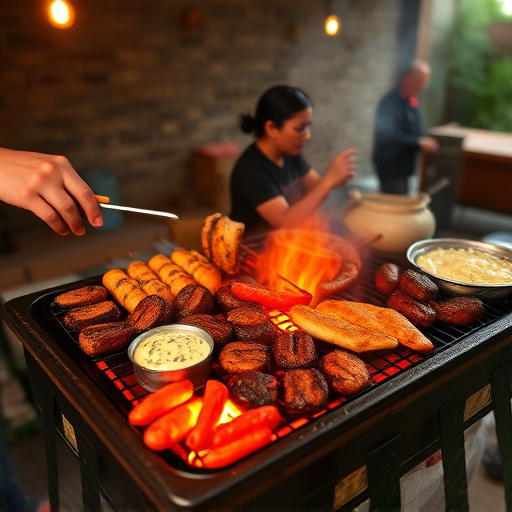
When it comes to crafting the perfect smoked BBQ brisket recipe, selecting the right cut is paramount. Look for a whole packer brisket with good marbling—the fat streaks within the meat—as this ensures both flavor and tenderness during the slow-smoking process. The ideal brisket should have a thin layer of fat cap on top, which will render down and add moisture to the meat. Opt for grass-fed, naturally raised beef for superior taste and texture.
Before smoking, trim excess fat (leaving about 1/4 inch) to balance flavor with tenderness. Seasoning is key; a generous coating of salt and pepper is a great starting point, but feel free to experiment with other spices and herbs like paprika, garlic powder, onion powder, cayenne pepper, and dried herbs such as thyme and rosemary. The goal is to create a balanced blend that enhances the natural flavors of the brisket without overpowering it. Proper preparation involves drying the meat thoroughly (a process known as “curing”) before smoking to lock in juices and achieve that coveted smoky, tender texture.
Dry Rubs vs Wet Marinades: Understanding Seasoning Techniques
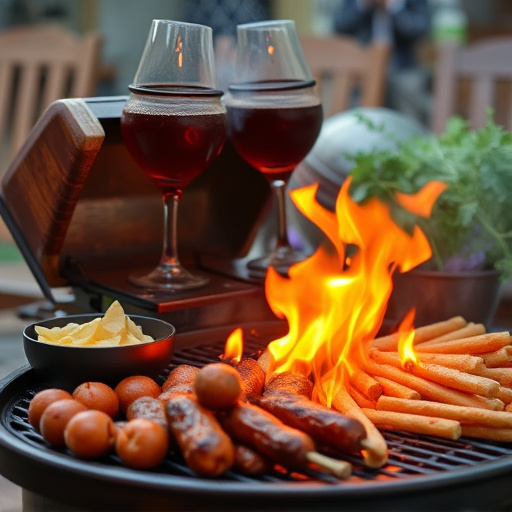
When it comes to seasoning smoked brisket, there are two primary techniques: dry rubs and wet marinades. Each has its unique benefits and contributes to the overall flavor profile in different ways. A dry rub is a mixture of spices and herbs that is directly applied to the meat before smoking. This method allows for a more intense, robust flavor as the spices stick to the surface, creating a delicious crust on the exterior while infusing the meat with a deep, savory taste. Dry rubs are versatile, offering a wide range of flavor combinations to suit different preferences.
On the other hand, wet marinades involve soaking the brisket in a liquid mixture of spices, herbs, and various ingredients like oils, acids, or preservatives. Wet marinades can tenderize the meat and add moisture, resulting in a more succulent brisket. This technique is particularly effective for longer smoking sessions as it helps combat dryness. Many smoked BBQ brisket recipes rely on wet marinades to enhance the overall eating experience, ensuring each bite is packed with flavor and juiciness.
The Art of Smoking: Setting Up Your BBQ for Optimal Results
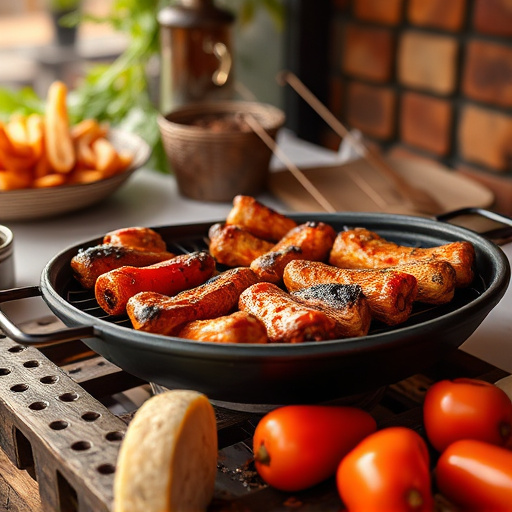
The art of smoking brisket is a meticulous process that requires the right equipment and techniques to achieve the perfect, tender, and flavorful result. When crafting your ideal smoked BBQ brisket recipe, consider the following tips for setting up your BBQ. First, choose a quality smoker that allows precise temperature control. Whether it’s a pellet smoker or a traditional charcoal setup, ensure it can maintain a steady, low temperature for many hours. Preheat your smoker and use a mix of hardwoods like oak, hickory, or mesquite to impart a smoky flavor without overpowering the meat’s natural taste.
Maintain a consistent environment inside the smoker by managing humidity levels. You can achieve this with water pans or injection sauces that keep the brisket moist as it cooks slowly. Regularly monitor and adjust the temperature throughout the cooking process, aiming for a final internal temperature of 203°F (95°C) to ensure the meat is thoroughly cooked and juicy. Patience is key; smoking brisket takes time, so let the slow cooking transform your tough cut into a melt-in-your-mouth delight that’s worth every minute spent waiting.
Spices and Herbs: Crafting the Perfect Blend for a Smoky Flavor
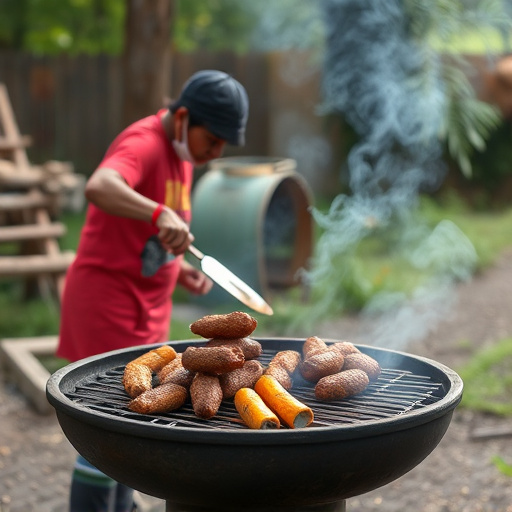
When it comes to crafting the perfect smoked BBQ brisket recipe, spices and herbs play a crucial role in enhancing the smoky flavor that makes this dish so irresistible. The key is to find the right balance—a delicate dance of heat, bitterness, tanginess, and earthy notes. Common contenders include salt, pepper, garlic powder, onion powder, paprika, chili powder, and cayenne, each contributing its unique character to the overall profile.
Herbs like rosemary, thyme, and bay leaves add depth and complexity, while a sprinkle of brown sugar or apple cider vinegar can provide a sweet and tangy contrast. The art lies in experimenting with different combinations and ratios until you hit upon that magical blend that transforms your brisket into something truly extraordinary. Remember, less is often more—a light hand with the spices allows the natural flavors of the meat to shine through while still imparting that delectable smoked aroma.
Slow Cooking Process: Time, Temperature, and Technique for Tender Brisket
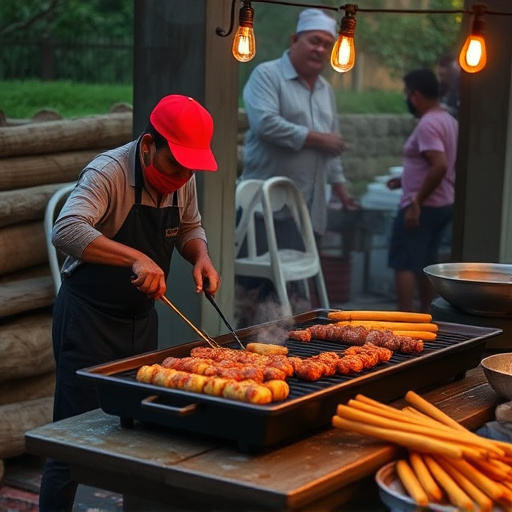
The slow-cooking process is an art for achieving tender, succulent smoked BBQ brisket. This method requires time, patience, and a precise technique to break down the tough muscle fibers in this cut of meat. Typically, brisket is cooked at low and steady temperatures ranging from 225°F to 250°F (107°C to 121°C) for an extended period. A quality smoked BBQ brisket recipe usually involves cooking the meat for around 1.5 to 2 hours per pound, ensuring it reaches an internal temperature of about 165°F (74°C). The key lies in maintaining a consistent environment within your smoker, using wood chips or chunks for flavor, and regularly baste or spray the brisket with a blend of spices and herbs. Slow cooking allows the rich flavors to penetrate deep into the meat, resulting in a tender, melt-in-your-mouth experience that is the hallmark of a perfect smoked BBQ brisket.
Presentation and Serving Suggestions: Making Your Smoked Brisket the Star of the Meal

When it comes to presenting your smoked BBQ brisket recipe, the goal is to make it the centerpiece of your meal, inviting guests to take a bite and indulge in its rich flavors. Start by slicing the brisket thinly across the grain, ensuring each slice is uniform for even cooking. Arrange the slices artfully on a platter, allowing the beautiful marbling of fat and meat to shine. Accompany with a selection of traditional BBQ sides like coleslaw, potato salad, or baked beans to complete the picture.
For an extra touch, consider adding a simple, homemade sauce on the side. This not only enhances the flavor but also adds a visual appeal. Use a blend of your favorite spices and herbs from your smoked brisket recipe to create a sauce that complements the meat perfectly. Serve in small bowls or cups, allowing diners to dip or drizzle as they please. The combination of tender brisket, crisp vegetables, and a tangy sauce will leave your guests craving more, making your smoked BBQ brisket recipe an unforgettable culinary experience.
